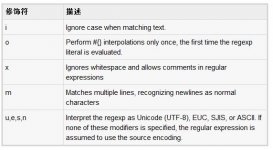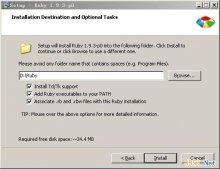本文跟大家分享的是在CentOS 7下配置Ruby语言开发环境的方法教程,分享出来供大家参考学习,下面来看看详细的介绍:
安装Ruby 2.2
CentOS7存储库中的Ruby版本为2.0,但如果需要,可以使用RPM软件包安装2.2
1、添加CentOS SCLo软件集合存储库
|
1
2
3
4
5
6
7
8
9
10
11
12
|
[root@linuxprobe ~]# yum -y install centos-release-scl-rh centos-release-scl# set [priority=10][root@linuxprobe ~]# sed -i -e "s/\]$/\]\npriority=10/g" /etc/yum.repos.d/CentOS-SCLo-scl.repo[root@linuxprobe ~]# sed -i -e "s/\]$/\]\npriority=10/g" /etc/yum.repos.d/CentOS-SCLo-scl-rh.repo# for another way, change to [enabled=0] and use it only when needed[root@linuxprobe ~]# sed -i -e "s/enabled=1/enabled=0/g" /etc/yum.repos.d/CentOS-SCLo-scl.repo[root@linuxprobe ~]# sed -i -e "s/enabled=1/enabled=0/g" /etc/yum.repos.d/CentOS-SCLo-scl-rh.repo# if [enabled=0], input a command to use the repository[root@linuxprobe ~]# yum --enablerepo=centos-sclo-rh install [Package][root@linuxprobe ~]# yum --enablerepo=centos-sclo-sclo install [Package]# 安装rubyyum --enablerepo=centos-sclo-rh -y install rh-ruby22 |
2、软件集合的软件包安装在/opt目录下, 要使用它,需要加载环境变量,如下所示:
|
1
2
3
4
5
6
|
# 加载环境变量[root@linuxprobe ~]# scl enable rh-ruby22 bash[root@linuxprobe ~]# ruby -vruby 2.2.2p95 (2015-04-13 revision 50295) [x86_64-linux][root@linuxprobe ~]# which ruby/opt/rh/rh-ruby22/root/usr/bin/ruby |
3、设置登录时自动启用Ruby 2.2,按如下所示进行配置:
|
1
2
3
4
5
|
[root@linuxprobe ~]# vim /etc/profile.d/rh-ruby22.sh#!/bin/bashsource /opt/rh/rh-ruby22/enableexport X_SCLS="`scl enable rh-ruby22 'echo $X_SCLS'`"export PATH=$PATH:/opt/rh/rh-ruby22/root/usr/local/bin |
安装Ruby 2.3
|
1
2
|
# 安装rubyyum --enablerepo=centos-sclo-rh -y install rh-ruby23 |
1、软件集合的软件包安装在/opt目录下, 要使用它,需要加载环境变量,如下所示:
|
1
2
3
4
5
6
|
# 加载环境变量[root@linuxprobe ~]# scl enable rh-ruby23 bash[root@linuxprobe ~]# ruby -vruby 2.2.2p95 (2015-04-13 revision 50295) [x86_64-linux][root@linuxprobe ~]# which ruby/opt/rh/rh-ruby22/root/usr/bin/ruby |
2、设置登录时自动启用Ruby 2.3,按如下所示进行配置:
|
1
2
3
4
5
|
[root@linuxprobe ~]# vim /etc/profile.d/rh-ruby23.sh#!/bin/bashsource /opt/rh/rh-ruby23/enableexport X_SCLS="`scl enable rh-ruby23 'echo $X_SCLS'`"export PATH=$PATH:/opt/rh/rh-ruby23/root/usr/local/bin |
安装Ruby on Rails 4来构建Ruby Framework环境
1、添加EPEL软件存储库
|
1
2
3
4
5
6
7
|
[root@linuxprobe ~]# yum -y install epel-release# set [priority=5][root@linuxprobe ~]# sed -i -e "s/\]$/\]\npriority=5/g" /etc/yum.repos.d/epel.repo# for another way, change to [enabled=0] and use it only when needed[root@linuxprobe ~]# sed -i -e "s/enabled=1/enabled=0/g" /etc/yum.repos.d/epel.repo# if [enabled=0], input a command to use the repository[root@linuxprobe ~]# yum --enablerepo=epel install [Package] |
Ruby on Rails 4
1、安装Ruby 2.2,参考上面
2、安装依赖包(epel+SCLo)
|
1
|
[root@linuxprobe ~]# yum --enablerepo=epel,centos-sclo-rh -y install rh-ruby22-ruby-devel nodejs libuv gcc make libxml2 libxml2-devel mariadb-devel zlib-devel libxslt-devel |
安装Rails 4
|
1
2
3
4
5
|
[root@linuxprobe ~]# gem install bundler[root@linuxprobe ~]# gem install nokogiri -- --use-system-libraries[root@linuxprobe ~]# gem install rails --version="~>4.0" --no-ri --no-rdoc[root@linuxprobe ~]# /opt/rh/rh-ruby22/root/usr/local/bin/rails -vRails 4.2.8 |
Ruby on Rails 5
1、安装Ruby 2.3,参考上面
2、安装依赖包(epel+SCLo)
|
1
|
[root@linuxprobe ~]# yum --enablerepo=epel,centos-sclo-rh -y install rh-ruby23-ruby-devel nodejs libuv gcc make libxml2 libxml2-devel mariadb-devel zlib-devel libxslt-devel |
安装Rails 5
|
1
2
3
4
5
|
[root@linuxprobe ~]# gem install bundler[root@linuxprobe ~]# gem install nokogiri -- --use-system-libraries[root@linuxprobe ~]# gem install rails --no-ri --no-rdoc[root@linuxprobe ~]# rails -vRails 5.0.2 |
创建一个示例应用程序,并确保其正常工作
1、需要安装MariaDB服务
|
1
2
3
4
5
6
7
8
|
[root@linuxprobe ~]# yum -y install mariadb-server[root@linuxprobe ~]# vi /etc/my.cnf# add follows within [mysqld] section[mysqld]character-set-server=utf8[root@linuxprobe ~]# systemctl start mariadb[root@linuxprobe ~]# systemctl enable mariadbln -s '/usr/lib/systemd/system/mariadb.service' '/etc/systemd/system/multi-user.target.wants/mariadb.service' |
2、初始化MariaDB
|
1
2
3
4
5
6
7
8
9
10
11
12
13
14
15
16
17
18
19
20
21
22
23
24
25
26
27
28
29
30
31
32
33
34
35
36
37
38
39
40
41
42
43
44
45
46
47
48
49
50
51
52
53
54
55
56
57
58
59
60
61
62
63
64
65
66
67
68
69
70
71
72
73
74
75
76
77
78
79
80
81
82
83
84
85
86
87
88
89
90
91
92
93
94
95
96
97
98
99
100
|
[root@linuxprobe ~]# mysql_secure_installationNOTE: RUNNING ALL PARTS OF THIS SCRIPT IS RECOMMENDED FOR ALL MariaDB SERVERS IN PRODUCTION USE! PLEASE READ EACH STEP CAREFULLY!In order to log into MariaDB to secure it, we'll need the currentpassword for the root user. If you've just installed MariaDB, andyou haven't set the root password yet, the password will be blank,so you should just press enter here.Enter current password for root (enter for none):OK, successfully used password, moving on...Setting the root password ensures that nobody can log into the MariaDBroot user without the proper authorisation.# set root passwordSet root password? [Y/n] yNew password:Re-enter new password:Password updated successfully!Reloading privilege tables.. ... Success!By default, a MariaDB installation has an anonymous user, allowing anyoneto log into MariaDB without having to have a user account created forthem. This is intended only for testing, and to make the installationgo a bit smoother. You should remove them before moving into aproduction environment.# remove anonymous usersRemove anonymous users? [Y/n] y ... Success!Normally, root should only be allowed to connect from 'localhost'. Thisensures that someone cannot guess at the root password from the network.# disallow root login remotelyDisallow root login remotely? [Y/n] y ... Success!By default, MariaDB comes with a database named 'test' that anyone canaccess. This is also intended only for testing, and should be removedbefore moving into a production environment.# remove test databaseRemove test database and access to it? [Y/n] y - Dropping test database... ... Success! - Removing privileges on test database... ... Success!Reloading the privilege tables will ensure that all changes made so farwill take effect immediately.# reload privilege tablesReload privilege tables now? [Y/n] y ... Success!Cleaning up...All done! If you've completed all of the above steps, your MariaDBinstallation should now be secure.Thanks for using MariaDB!# connect to MariaDB with root[root@linuxprobe ~]# mysql -u root -pEnter password:Welcome to the MariaDB monitor. Commands end with ; or \g.Your MariaDB connection id is 11Server version: 5.5.52-MariaDB MariaDB ServerCopyright (c) 2000, 2016, Oracle, MariaDB Corporation Ab and others.Type 'help;' or '\h' for help. Type '\c' to clear the current input statement.# show user listMariaDB [(none)]> select user,host,password from mysql.user;+------+-----------+-------------------------------------------+| user | host | password |+------+-----------+-------------------------------------------+| root | localhost | *E2ACEC2F2DA384EE6753673365DFEF35F0C272C9 || root | 127.0.0.1 | *E2ACEC2F2DA384EE6753673365DFEF35F0C272C9 || root | ::1 | *E2ACEC2F2DA384EE6753673365DFEF35F0C272C9 |+------+-----------+-------------------------------------------+3 rows in set (0.00 sec)# show database listMariaDB [(none)]> show databases;+--------------------+| Database |+--------------------+| information_schema || mysql || performance_schema |+--------------------+3 rows in set (0.00 sec)MariaDB [(none)]> exitBye |
3、创建测试应用程序
|
1
2
3
4
5
6
7
8
9
10
11
12
13
14
15
16
17
18
19
20
21
22
23
24
25
26
27
|
[root@linuxprobe ~]# gem install mysql2 --no-ri --no-rdoc -- --with-mysql-config=/usr/bin/mysql_config[root@linuxprobe ~]# rails new SampleApp -d mysql[root@linuxprobe ~]# cd SampleApp[root@linuxprobe SampleApp]# vi config/database.ymldefault: &default adapter: mysql2 encoding: utf8 pool: 5 username: root password: password # MariaDB password socket: /var/lib/mysql/mysql.sock# create test application[root@dlp SampleApp]# rails db:createCreated database 'SampleApp_development'Created database 'SampleApp_test'[root@dlp SampleApp]# rails generate scaffold testapp name:string title:string body:text[root@dlp SampleApp]# rails db:migrate[root@dlp SampleApp]# rails server --binding=0.0.0.0=> Booting Puma=> Rails 5.0.2 application starting in development on http://0.0.0.0:3000=> Run `rails server -h` for more startup optionsPuma starting in single mode...* Version 3.8.2 (ruby 2.3.1-p112), codename: Sassy Salamander* Min threads: 5, max threads: 5* Environment: development* Listening on tcp://0.0.0.0:3000Use Ctrl-C to stop |
4、客户端访问http://10.1.1.53:3000/

总结
以上就是这篇文章的全部内容了,希望本文的内容对大家的学习或者工作能带来一定的帮助,如果有疑问大家可以留言交流,谢谢大家对服务器之家的支持。
原文链接:http://blog.csdn.net/wh211212/article/details/70060854




